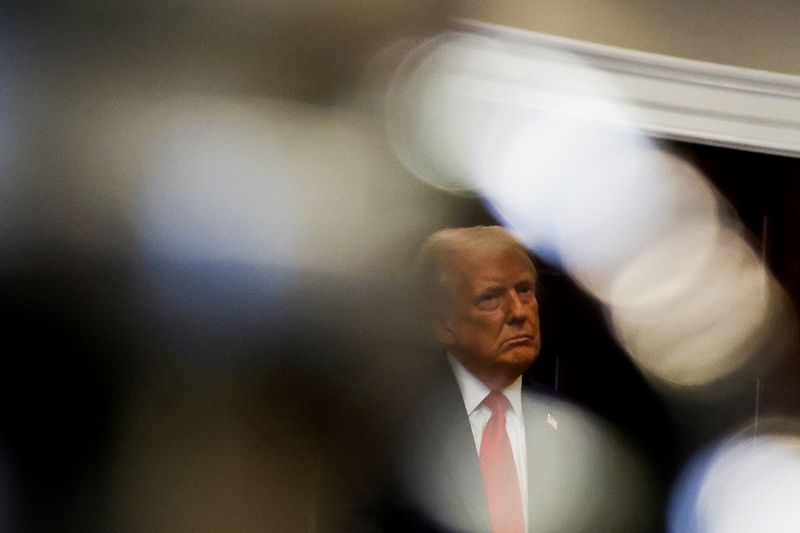
A look at the day ahead in U.S. and global markets from Mike Dolan
With quarter-end fast approaching, tech excitement returned to Wall Street overnight with another AI-driven earnings beat from Micron Technology (NASDAQ:MU), while China’s stocks surged anew after this week’s monetary easing blitz.
The artificial intelligence theme had gone a bit flat in recent weeks as attention switched to aggressive Federal Reserve interest rate cuts – but Micron added fresh fizz overnight.
Its stock surged 14% after the bell as it revealed the highest quarterly revenue growth in more than a decade on the back of booming demand for its AI-related memory chips.
With investor attention turning to the upcoming third-quarter earnings season, Micron’s results typically set the tone for the chip sector as it reports ahead of peers and serves a broad client base spanning PCs, data centers and smartphone industries.
And that’s lifted Wall Street futures again after a downbeat Wednesday, with Nasdaq futures up more than 1% ahead of Thursday’s open.
Perhaps due to some erratic flows related to the end of the third quarter, global market moves have turned somewhat scattergun.
But the dominant themes remain: worldwide interest rate cuts and a U.S. ‘soft landing’, disinflation encouraged by a fresh oil price plunge, China’s latest stimulus push, and the looming U.S. election.
The Swiss National Bank became the latest major central bank to cut interest rates – its third cut of the year, knocking another quarter point off its policy rate to just 1% and flagging further easing ahead. The franc weathered the expected move well against a generally firmed dollar index.
Disinflation pressures mounted in the energy markets again on Thursday, with crude oil prices sliding on a Financial Times report that Saudi Arabia is preparing to abandon its unofficial price target of $100 a barrel as it prepares to increase output.
U.S. crude prices slumped back below $70 per barrel, magnifying year-on-year declines to some 25% – a likely powerful downward force on headline annual inflation rates throughout September.
Fed Governor Adriana Kugler kept U.S. easing hopes on the boil overnight too. While insisting that the inflation target was not yet in the bag and further moves were “data dependent”, she added that rapid disinflation meant the Fed needed to cut just to keep the level of restrictiveness in policy steady.
China’s market revival this week also took a new leg higher, with another 4%-plus leap in both mainland Chinese shares and in Hong Kong.
Led by gains in the embattled property sector, the latest spur came after Beijing pledged more policy measures on growth just days after announcing a series of big rate cuts and funding for the markets.
State media, citing a Politburo meeting on the economic situation, reported that China would step up counter-cyclical adjustments of fiscal and monetary policy and strive to achieve full-year economic and social development targets.
Reuters sources said China plans to issue special sovereign bonds worth about 2 trillion yuan ($284.43 billion) this year as part of a fresh fiscal stimulus.
The offshore yuan continued to test 7 per dollar, close to its best levels since May of last year.
Back on Wall Street, Wednesday’s stalling near record highs looks set to be a temporary setback, with the tech news overnight adding to upbeat new homes sales during the session that has aided economic ‘soft landing’ hopes.
Super-sensitive soundings from the labor market are back on the slate on Thursday with weekly jobless readings, and the August PCE inflation report – which Fed governor Christopher Waller said last week was one decisive factor in the outsize rate cut – is due on Friday.
Treasury yields held up on Thursday amid this week’s series of auctions, with the two-year hovering around 3.55% and the 10-year yield at 3.77%. The newly positive 2-10 year yield curve gap held just above 20 basis points.
The U.S. Congress passed a stopgap bill on Wednesday to avert a partial government shutdown beginning next week, even as a large number of House Republicans revolted against their leadership for failing to achieve new federal spending cuts.
The measure will maintain the government’s current level of roughly $1.2 trillion in annual discretionary funding through Dec. 20, avoiding the furloughing of thousands of federal workers and the shutdown of a wide swath of government services just weeks before the Nov. 5 election.
U.S. Vice President Kamala Harris said on Wednesday she would offer tax credits to domestic manufacturers and invest in sectors that will “define the next century”, as she detailed her economic plan to boost the U.S. middle class.
Key developments that should provide more direction to U.S. markets later on Thursday:
* U.S. weekly jobless claims, August pending home sales, August durables goods orders, Q2 GDP revision, Kansas City Fed Sept business survey
* Mexico central bank policy decision
* Federal Reserve Board Governor Michelle Bowman and Lisa Cook both speak, New York Fed President John Williams, Boston Fed chief Susan Collins, Minneapolis Fed chief Neel Kashkari and Fed Vice Chair for Supervision Michael Barr all speak; European Central Bank President Christine Lagarde and ECB board members Luis de Guindos and Isabel Schnabel all speak

* US corporate earnings: Costco (NASDAQ:COST), Carmax, Jabil, Accenture (NYSE:ACN)
* US Treasury sells $44 billion of 7-year notes, auctions $90 billion of 4-week bills
(By Mike Dolan, editing by Gareth Jones; [email protected])
This post is originally published on INVESTING.



